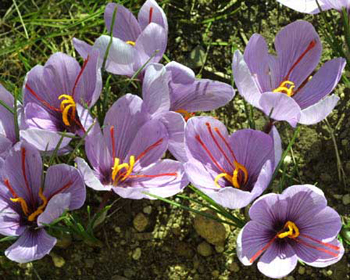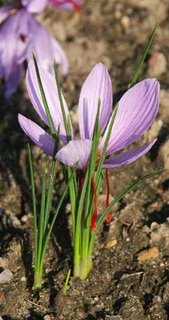Contents:
Common Names | Parts Usually Used | Plant(s) & Culture | Where Found | Medicinal Properties | Biochemical Information
Legends, Myths and Stories | Uses | Formulas or Dosages | How Sold | Warning | Resource Links | Bibliography
Scientific Names

- Crocus sativus L.
- Iridaceae
- Iris family
Common Names
- American saffron
- Autumn crocus
- Bastard saffron
- Dyer’s saffron
- False saffron
- Fan-hung-hua (Chinese name)
- Nagakeshata (Sanskrit name)
- Parrot’s corn
- Safflower (safflower is really Carthamus tinctorius L.)
- Saffron seed
- Spanish saffron
- Thistle saffron
Parts Usually Used
The stigmas (use only the anthers; corms are poisonous)
Back to Top
 Description of Plant(s) and Culture
Description of Plant(s) and Culture
Saffron is a small perennial plant; in springtime, an onion-like corm produces basal, linear leaves which are surrounded as a group at the bottom by cylindrical sheaths. These gray-green leaves have hairy margins and grow to about 8 inches long. About August or September, the corm produces a funnel-shaped, reddish-purple (sometimes lilac or white) flower. These crocus-like flowers appear in late September, and the grasslike leaves can stay green until the following spring and are an attractive feature in the winter garden.
Back to Top
Where Found
Cultivated in many places, but particularly in France, Spain, Sicily, and Iran.
Back to Top
Medicinal Properties
Alterative, anodyne, antispasmodic, aphrodisiac, appetizer, emmenagogue, expectorant, sedative, seed aromatic, stimulant, laxative, diuretic, abortive
Back to Top
Biochemical Information
When dried, the stigmas produce a glycoside called picrocine which then forms safranal. This has the characteristic smell and the carotenoid pigment of crocine (a very powerful yellow pigment highly valued in the Middle East for the fine quality of yellow dye it yields, even in 1 part per 100,000 it will color water yellow).
Back to Top
Legends, Myths and Stories
The most delicately flavored of all spices. Adds golden color and a wonderful flavor to rice dishes, soups, etc. The most expensive of all spices, saffron fortunately needs to be used only in very small quantities. As a culinary herb, it is used for food coloring.
True saffron is perhaps the most expensive of all plant products because of the labor involved in harvesting and it takes 3 acres of flowers to produce 1 lb. of saffron. It retails for about $40 an ounce! For this reason few dealers stock this botanical. False saffron, or safflower (Carthamus tinctorius L.) is used much like true saffron.
afflower contains 2 coloring principles; the one yellow and the other red. The first is removed by water and used mainly in cooking. The second is used in dyeing fabrics and is easily dissolved out by weak solutions of carbonated alkalies, and is again precipitated with the addition of acid. This property is used to manufacture rouge, and in the dyeing of silk, cotton, and wool.
If you wish to collect the stigmata yourself, be sure to plant thousands of saffron, for 60,000 stigmata weight only 1 pound. It takes 50,000 stigmata to make 1 ounce of saffron spice. The stigmata is a small part of the pistil of the flower.
At one time, saffron was highly regarded for its medicinal properties. In 1597, the English herbalist John Gerard wrote about saffron as being the remedy for bringing a person back from death’s door. Today, saffron is used primarily used, by those who can afford it, in cooking.
Saffron was taken from Arabia to China by Chang Chien, at the same time he took safflower and other Western drugs and plants.
Back to Top
Uses
Saffron has been used, in small doses only, for coughs, whooping cough, stomach gas, gastrointestinal colic, consumption, quickens the brain, jaundice, and insomnia. Used for menstrual pain, menopause, irregular menses, impotence, infertility, anemia, enlarged liver, hysteria, depression, neuralgia, lumbago, rheumatism, and chronic diarrhea. As an ingredient in herb liqueurs, it serves as a stimulant to appetite; it is sometimes made into a salve for treatment of gout. Reliable used for measles, all skin diseases, and scarlet fever. Will produce profuse perspiration when taken hot: useful for fever, colds, cough, asthma, and the grippe. Regulates and increases the menstrual flow. Blood vitalizer, counteracts inflammatory conditions.
Back to Top
Formulas or Dosages
Infusion: steep 6-10 stigmas in 1/2 cup water. Take 1/2 to 1 cup a day, unsweetened, a mouthful at a time.
Back to Top
How Sold
Available in a tincture, but is quite expensive. Because it is much cheaper, safflower (Carthamus tinctorius L.) has been used as a substitute for saffron, sometimes under the misleading name of American or Mexican saffron.
Back to Top
Warning
Saffron contains a poison that acts on the central nervous system and damages the kidneys. Large doses can have severe effects; 10-12 grams is a fatal dose for humans. The high cost of saffron and the availability of synthetic substitutes make its use as a medicine rare.
Use only the anthers; corms are poisonous.
In large doses it can be narcotic, toxic and even lethal, causing violent hemorrhages. Definitely should not be used during pregnancy; this is a uterine stimulant and may cause miscarriage.
Back to Top
Resource Links
You can grow and harvest your own saffron! Find out more here.
Bibliography
![]() Back to Eden
Back to Eden, by Jethro Kloss; Back to Eden Publishing Co., Loma Linda, CA 92354, Original copyright 1939, revised edition 1994
![]() Chinese Medicinal Herbs
Chinese Medicinal Herbs, compiled by Shih-Chen Li, Georgetown Press, San Francisco, California, 1973.
![]() Culpeper’s Complete Herbal & English Physician: Updated With 117 Modern Herbs
Culpeper’s Complete Herbal & English Physician: Updated With 117 Modern Herbs, by Nicholas Culpeper, Meyerbooks, publisher, PO Box 427, Glenwood, Illinois 60425, 1990, (reprint of 1814)
 Earl Mindell’s Herb Bible
Earl Mindell’s Herb Bible, by Earl Mindell, R.Ph., Ph.D., Simon & Schuster/Fireside, Rockefeller Center 1230 Avenue of the Americas, New York, New York 10020
 Old Ways Rediscovered
Old Ways Rediscovered, by Clarence Meyer, Meyerbooks, publisher, PO Box 427, Glenwood, Illinois 60425, published from 1954, print 1988
![]() The Herb Book
The Herb Book, by John Lust, Bantam Books, 666 Fifth Avenue, New York, NY. copyright 1974.
Herbal Gardening, compiled by The Robison York State Herb Garden, Cornell Plantations, Matthaei Botanical Gardens of the University of Michigan, University of California Botanical Garden, Berkeley., Pantheon Books, Knopf Publishing Group, New York, 1994, first edition
![]() Planetary Herbology
Planetary Herbology, by Michael Tierra, C.A., N.D., O.M.D., Lotus Press, PO Box 325, Twin Lakes. WI 53181., Copyright 1988, published 1992
![]() Indian Herbalogy of North America
Indian Herbalogy of North America, by Alma R. Hutchens, Shambala Publications, Inc., Horticultural Hall, 300 Massachusetts Avenue, Boston, Massachusetts 02115, 1973
![]() American Folk Medicine
American Folk Medicine, by Clarence Meyer, Meyerbooks, publisher, PO Box 427, Glenwood, Illinois 60425, 1973
![]() The Yoga of Herbs: An Ayurvedic Guide to Herbal Medicine
The Yoga of Herbs: An Ayurvedic Guide to Herbal Medicine, by Dr. David Frawley & Dr. Vasant Lad, Lotus Press, Twin Lakes, Wisconsin, Second edition, 1988.
![]() Webster’s New World Dictionary
Webster’s New World Dictionary, Third College Edition, Victoria Neufeldt, Editor in Chief, New World Dictionaries: A Division of Simon & Schuster, Inc., 15 Columbus Circle, New York, NY 10023
 The Rodale Herb Book: How to Use, Grow, and Buy Nature’s Miracle Plants (An Organic gardening and farming book)
The Rodale Herb Book: How to Use, Grow, and Buy Nature’s Miracle Plants (An Organic gardening and farming book), edited by William H. Hylton, Rodale Press, Inc. Emmaus, PA, 18049., 1974
